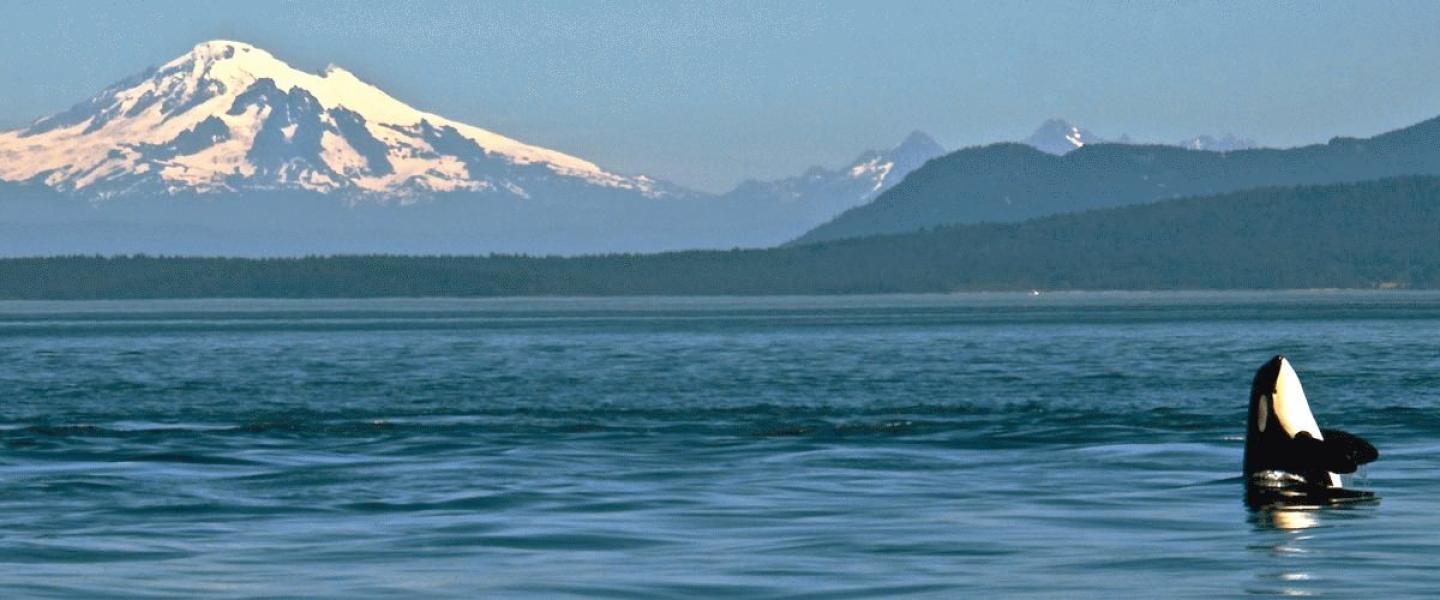
There are stories surrounding orcas that say if we visit them in their natural realm, the sea, we'll see them as humans since they will be home and we will be the visitor. I don't know what that means the human will then look like, but I like to think of humans with permanently grinning orca faces.
Unless you don a drysuit and some air tanks there is no one to see if this little myth is true but I believe it's good to think of orcas in a more human way, to connect with them emotional, and maybe guess at what their thinking.
We headed out on Thursday even with a slight breeze and calm waters. We headed towards Alden Bank near Patos and Sucia Islands and had a beautiful trip skirting along the north side of the islands watching Murres and Cormorants, our daring cliff dwelling birds, fly past steep island coastlines. When we arrived, we soon spotted a lot of dorsal fins. It was a large group of K pod! The sunlight was at such an angle that the dorsal fins looked jet black on the front and aflame in the back as these two families milled for Salmon in the orange light given by the end of the day. Tika (K-33) appeared directly behind us startling me with his loud breath and impressing everyone with his tall dorsal fin. Tika is a Chinook word meaning swift and he is definitely that. We watched him go in and out of salmon schools and soon started to see the rest of his family in the K-12's swim closer. Sequim (K-12) is the matriarch and her three children we all there: Sekiu (K-22), Rainshadow (K-37), and Saturna (K-43). Saturna even popped up in front of her namesake island of Saturna in the distance! Sekiu (K-22) is the mother of Tika, and it was amazing to see three generations to pass by.
We saw some splashing in the distance and decided to go investigate. It was the K-13's! My favorite family with Skagit (K-13) as the matriarch and leading the group. Skagit has a large family with her children: Spock (K-20), Scoter (K-25), Deadhead (K-27), and Cali (K-34) and her grandchildren: Comet (K-38) and Ripple (K-34). I personally got distracted by either Skagit or Cali breaching in the distance that I didn't even notice Spock (k-20) and her child Comet (K-38) swim past on the other side of the boat! Those too are my favorite, and Spock is interesting because researchers thought that she was male for awhile because of her male looking dorsal fin...until she had a calf. Whoops.
Spock and Comet swimming right next to each other, now that's something. This mother-son pair swam calmly by and it's interesting to compare their relationship and behavior with other mother-child pairs. Especially when Comet started jumping over and over in front of his mom with his mom responding with tail slap after tail slap on the water.
As we thought about each whale and how differently they behave kind of like how different humans act we watched them swim by one last time through the golden stream of sunlight brought by one of the most amazing sunsets I've seen over Vancouver Island. It's certainly a feeling I don't think any of us will lose for a very long, long time.
Whale folks until next time,
Naturalist Erick
M/V Sea Lion, San Juan Safaris